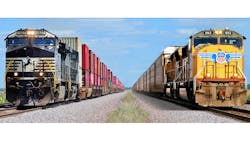Union Pacific Signs Deal to Merge with Norfolk Southern
Union Pacific Corp. and Norfolk Southern Corp. have announced their plans to merge into what they describe as “America’s first transcontinental railroad” (although that distinction actually goes to the Pacific Railroad, which was famously created more than 150 years ago). The plan, should the merger go through (and that’s somewhat in doubt at the moment), would connect over 50,000 route miles across 43 states from the East Coast to the West Coast, linking up roughly 100 ports throughout North America.
The agreement’s terms have Union Pacific acquiring Norfolk Southern in a stock and cash transaction valued at roughly $85 billion, with the end result being the creation of a combined enterprise of over $250 billion. The new company would be known as the Union Pacific Transcontinental Railroad.
Both companies have said that “every union employee who wants a job in the combined company will have one. The goal, they state, is to :deliver faster, more comprehensive freight service to U.S. shippers by eliminating interchange delays, opening new routes, expanding intermodal services, and reducing distance and transit time on key rail corridors.
The merger announcement was met with some early skepticism from various industry groups. For instance, the American Chemistry Council (ACC) released a statement saying, “ACC and its member companies have serious concerns about the negative impacts on American manufacturing from further consolidation in the freight rail industry. We are closely watching the proposed terms of the deal and will actively oppose any merger that fails to significantly enhance competition between railroads. Our industry is one of the largest users of the U.S. freight rail system, and we need efficient and reliable service to deliver products that make people's lives better, healthier and safer.
“The four largest freight railroads already control more than 90% of U.S. rail traffic, with two dominating in the eastern U.S. and two dominating in the west. The impact of a transcontinental merger between two of these railroads threatens to leave American manufacturers, farmers and energy producers with even fewer competitive options to ship by rail. Many rail customers are currently dealing with high rates and unreliable service. Further consolidation within the rail industry is likely to make these problems worse.”
SMART Transportation Division (SMART-TD), a labor union representing the rail industry, questions whether the merger will lead to improved rail service, worker safety, and infrastructure. In a statement, SMART-TD aimed most of its critical comments at Union Pacific, in particular citing UP’s “troubling safety record,” its “pattern of disengagement and hostility” toward labor relations, and “an alarming willingness to lease yards and even mainline trackage to non-union Class II and Class III railroads in pursuit of short-term financial gains.” In short, the union plans to oppose the merger when it comes up for approval before the Surface Transportation Board (STB)
The companies expect to file their application with the STB within six months, and they are targeting closing the transaction by early 2027.
